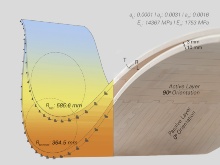Material Driven Computational Design and Manufacturing for Self-Forming Curved Wood Furniture
This research investigates the design and fabrication space of self-forming curved wooden furniture through an interdisciplinary collaboration between architects, engineers, material scientists, and forest scientists. In the current manufacturing process, seating furniture often includes curved elements that are typically achieved by applying external forces via large pressing tools and individually shaped molds, especially for wooden furniture. Therefore, despite the sustainable advantages of the material and the appealing aesthetics of the final product, the existing production method restricts the ability to customize furniture pieces and hinders cost-effectiveness, particularly when producing small series of elements. Besides, the resulting pieces of furniture often present logistical difficulties due to their substantial space requirements.
By harnessing the anisotropic structure of wood and its differential swelling and shrinkage properties, this research builds upon an innovative self-forming process that was explored in the HygroShape project. One approach to leverage the capabilities of this technology is to produce the furniture pieces in flatpack configurations that are designed to autonomously shape themselves when unpacked. This process involves the use of adhesively bonded regional hardwood layers, strategically programmed and arranged to induce the desired final shape during the on-site drying process. An additional approach includes the fabrication and locking of the curved furniture pieces, which obviates the requirement for large pressing tools and molds. Furthermore, the advancement of computational methods helps investigate the design domain of such structures.
The long-spanning project delves into expanding the design and fabrication possibilities of such structures through material characterization, long-term testing, mechanical analysis, investigation of design possibilities, and furniture manufacturing. To enhance precision and control, a digital design methodology will be developed to model component construction, estimate shape changes, simulate deformations and performance, and facilitate a reverse-design process. Additionally, the project aims to propose and test locking mechanisms that stabilize curvature at predetermined levels, reducing variations in shape caused by the inherent anatomical variability of wood.
Combining the integration of digital design techniques, this project strives to introduce a manufacturing process for wooden furniture that is both economically viable and customer-oriented. The proposed approach leverages the intrinsic hygroscopic behavior of the material as a driving factor for the design and fabrication of self-forming furniture.
PROJECT TEAM
ICD Institute for Computational Design and Construction, University of Stuttgart
Ekin Sila Sahin, Laura Kiesewetter, Tiffany Cheng, Prof. Achim Menges
Student Asisstant: Laura Marsillo
Institute for Forest Utilization and Forest Technology, Technical University of Dresden
Prof. Dr. Markus Rüggeberg
Institute for Wood Technology Dresden, non-profit GmbH (IHD)
Prof. Detlef Krug, Prof. Steffen Tobisch
EXTERNAL ACADEMIC COLLABORATOR
Asst. Prof. Dr.-Ing. Dylan Wood
INDUSTRY ADVISORS
Danzer Deutschland GmbH
Thonet GmbH
Henkel & Cie. AG
Blumer-Lehmann AG
PROJECT FUNDING
Bundesministerium für Ernährung und Landwirtschaft (BMEL)
FNR -Förderprogramm Nachwachsende Rohstoffe des BMEL (2221HV096C)


